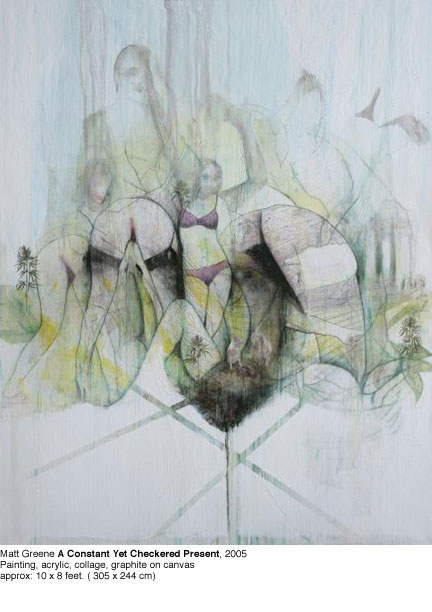Interview with artist Matt Greene
02.02.06
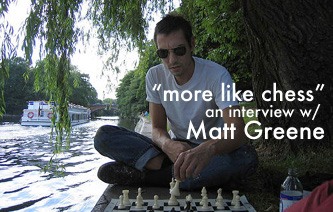 Interviewing Matt Greene was a bit like conversing with someone standing behind a curtain. Not that he’s weird like that, but I’ve never met him in person. I walked through his recent show here at Peres Projects Berlin trying to suss him out, and then the interview was by email; me in Berlin, he in Los Angeles.
Interviewing Matt Greene was a bit like conversing with someone standing behind a curtain. Not that he’s weird like that, but I’ve never met him in person. I walked through his recent show here at Peres Projects Berlin trying to suss him out, and then the interview was by email; me in Berlin, he in Los Angeles.
In the gallery, and during our correspondence, I was trying to figure out where the layers of porn, mushrooms, flora and blackness were taking me. It wasn’t clear if it was morbidity or abundance with the upper hand. The paintings, which always seem to tangle in the middle, jungled up even the lofty spaciousness of the Peres gallery. Streams of blackness flowed from the sexes of naked women, and I couldn’t decide if that was really something primordial, or somehow an expression of the horror of death. I currently have one theory that charms me: I think the mushrooms that adorn ‘For the Eyes of our Fathers’, pressing out from the rest of the visual field, are pregnant.
But a painting is ruined by the sentences describing it. Beyond imagery, the work shows a view of the world pointed somewhere above and beyond the normal anthropocentric frame. Something like all life and all death and all its in-betweens. This viewpoint itself, a sacred act of transgression.
 FANZINE: I would like to start with the concept of wonder. When I was walking through the show in Berlin, I remembered one of my favorite quotes from the French author Louis René des Forêts: "That there should exist in the world so much other than himself leaves him suddenly as breathless as a child." I’m not sure if this related to the intricate mushrooms on "For the eyes of our fathers" or the streaming black crotches in other pieces. In any case, it seemed wonder was a key element, and especially the wonder of mushrooms. When did this fascination begin?
FANZINE: I would like to start with the concept of wonder. When I was walking through the show in Berlin, I remembered one of my favorite quotes from the French author Louis René des Forêts: "That there should exist in the world so much other than himself leaves him suddenly as breathless as a child." I’m not sure if this related to the intricate mushrooms on "For the eyes of our fathers" or the streaming black crotches in other pieces. In any case, it seemed wonder was a key element, and especially the wonder of mushrooms. When did this fascination begin?
MATT GREENE: I became interested in identifying mushrooms as I spent more time hiking in the local mountains (the San Gabriels) and becoming aware of the seasonal micro changes in the environment. One day in winter I found a mushroom called Wood Blewit (lepista nuda) poking up out of the leaves and examined it for a long time. It was the exact same purple-brown color as all of the leaf litter and yet it had a different texture, fleshier than everything else on the ground. When I started walking again I realized that I could locate that mushroom from hundreds of feet away, even under the leaves – I trained my eyes to recognize the pattern of something that I had previously neglected to look for but was all around me. Now this mountain trial that I had walked for years had a new ecstatic layer of information for me. I started learning more about fungi and the complex interrelationships between organisms, and thinking about how hunter-gatherers must have had such a keen understanding of their surroundings to survive. I thought about how industrial production and consumption destroys this sensibility and is therefore unsustainable. I started understanding that the mushroom is just the fruiting or sexual body of an otherwise invisible organism with a complicated position in its immediate surroundings, that at a certain point we must fully accept that we cannot quantify or even see everything in the universe. I always liked the Romanticist idea of humanity’s smallness in the scale of the world; I think it is a political necessity to create reminders of the limits of our perception and our position in an ecosystem. My experience of wonder at first learning how to see mushrooms led me to appreciate the power of vision in breaking down anthropocentrism.
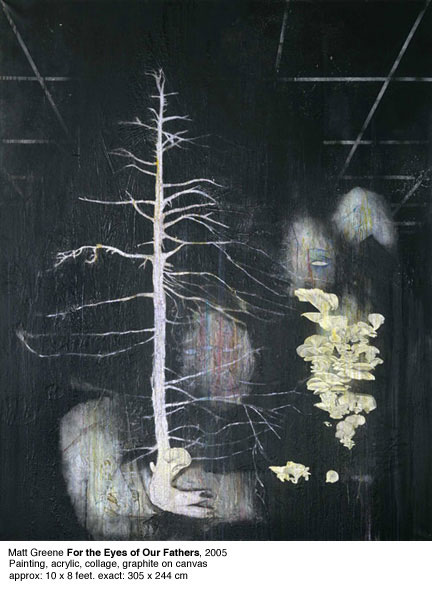 FANZINE: You say it is necessary ‘to create reminders of the limits of our perception and our position in an ecosystem,’ If I assume correctly, that this relates to making art, it seems connected with a shaman’s work of mediating between the human world and larger ecological (or non-human) world. Do you see your work functioning at least in part in this way?
FANZINE: You say it is necessary ‘to create reminders of the limits of our perception and our position in an ecosystem,’ If I assume correctly, that this relates to making art, it seems connected with a shaman’s work of mediating between the human world and larger ecological (or non-human) world. Do you see your work functioning at least in part in this way?
GREENE: Exactly. While I’m quick to point out that I do not live in a shamanistic culture and I’m pretty critical of new age pseudo-religions, I think that there is a great deal to be learned from the anthropological study of so called primitive cultures. For example, Pierre Clastres discovers in the study of South American chiefdoms complicated sets of conditions to prevent the formation of power structures (i.e., that the chief or spokesperson for a community would not be allowed to have any possessions). Far from being unenlightened, over thousands of years they have managed to maintain a stable relationship to their ecosystem by consciously not expanding according to the empire model.
There seems to be a strain of thinking that the Western/industrial notion of progress, rooted as it is in a linear conception of time, is a construct devised to support belief in the concept of centralized power, power based on subjugation. The essential character of shamanism is a belief in time as a permeable fabric. The shaman, in a visionary state, can consult with deceased ancestors for advice. This practice implies valuing a sustainable relationship between the culture and its surroundings through concepts like animism. the question in my mind is how to synthesize a belief system based on a responsible approach to the environment with contemporary science. Is a painting capable of doing this? That’s debatable. I believe that culture, especially in its most "primitive" or atavistic forms, has real potential to question and keep in check what I see as destructive forces of conquest, power and social hierarchies.
On the other hand, my work is very intuitive and associative and does not actually have an association to a text. I like to maintain ambiguity between the discursive and the fetishistic.
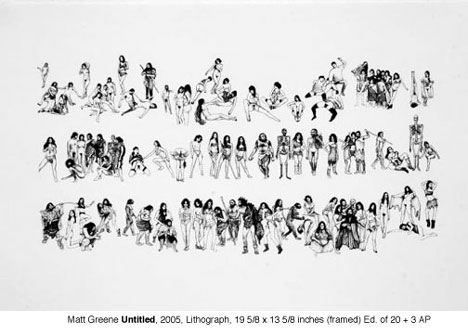 FANZINE: The paintings from the last exhibition [‘the wilderness is gathering her children once again’] were painted over summer in Berlin. How did your process vary between here [Berlin] and Los Angeles? Did working in Berlin have any effect on your work? Or did you come to realize any specific importance of working in California, especially considering the natural environment (parks, wilderness/lack of etc.)?
FANZINE: The paintings from the last exhibition [‘the wilderness is gathering her children once again’] were painted over summer in Berlin. How did your process vary between here [Berlin] and Los Angeles? Did working in Berlin have any effect on your work? Or did you come to realize any specific importance of working in California, especially considering the natural environment (parks, wilderness/lack of etc.)?
GREENE: I worked with some images from German rubber fetish magazines of women in raincoats for "the mushroom hunters"; that’s not a genre I would have come across in sunny California. I spent lots of time lying on the grass along the canal in Kreuzberg. I think it made me a little lazy in the studio. Berliners have a very relaxed work ethic and it’s contagious. On the other hand, the intellectual climate is much more rigorous. Strangers would peek in the windows of my studio and offer brutal criticisms of my work in progress. I felt like I needed a strategy if I was going to be painting, so I spent way more time outside thinking. I started thinking of artmaking as being more like playing chess than ejaculating.
 FANZINE: It’s so exciting to discover a local fetish specialty… It always divulges a peculiar rule or widespread nightmare (like the octopus in Japan and Taiwan). You mentioned earlier the ways various “primitive” cultures check the forces of conquest, power and social hierarchy. In contrast, I sometimes wonder if fetish and porn images offer a sort of carnival retreat beyond the reaches of the state (I am thinking specifically about Mexican carnivals and how it is that for one day men can dress like women). How did using porn initially come into your work? Has your way of using it changed since?
FANZINE: It’s so exciting to discover a local fetish specialty… It always divulges a peculiar rule or widespread nightmare (like the octopus in Japan and Taiwan). You mentioned earlier the ways various “primitive” cultures check the forces of conquest, power and social hierarchy. In contrast, I sometimes wonder if fetish and porn images offer a sort of carnival retreat beyond the reaches of the state (I am thinking specifically about Mexican carnivals and how it is that for one day men can dress like women). How did using porn initially come into your work? Has your way of using it changed since?
GREENE: I had been working with images of androgyny from rock culture, thinking about the politics of ambiguous gender. I came across Leslie Feinberg’s writing about how the construction of social distinctions between bodies is the first step towards creating an oppressive state. She documented the parallel histories of gender and labor revolts, such as the Luddites who wore women’s aprons while burning down the factory that made them. The first paintings I showed were utopian orgies populated by early Alice Cooper types, punk girls and trannies in satin. They were not retreating from the state, they were overcoming it. Anarchy and environmentalism are real sexy to me. I was using images from pornography as an easy reference tool for the body positions I was looking for to tell a story.
Of course, there is a limit to the narrative capacity of an image. over time my choices of images became more fetishistically specific and less a casting for a theatrical space. I wanted to find a way to make the construction of the painting more like the thinking that inspired the collection of the images, layers of phantasmagoria connected by associations. I wanted to explore other forms of ambiguity – besides gender, I wanted to break down distinctions between organisms, life and death. I wanted to sexualize the concept of the ecosystem.
The study of fetishism is the study of the limitations of our consciousness. The internet has exponentiated the availability of porn and creates new genres constantly. Ultimately, this shows us that we have an endless capacity to find things to replace the body. All art has some form of pygmalionism (or repression) at its core.
Orchids enlist the sexuality of bees to reproduce. Visual cues lure bees to copulate with the flower and get covered in pollen, which they then transfer to other flowers. It could be said that the wings of bees are the wings of orchids. These two organisms have co-evolved because of fantasy. human sexuality is so dependent on our subjective senses and so easily transferred onto objects other than the body. To what extent are we enlisted to benefit other organisms? This was the subject of "the pollinators".
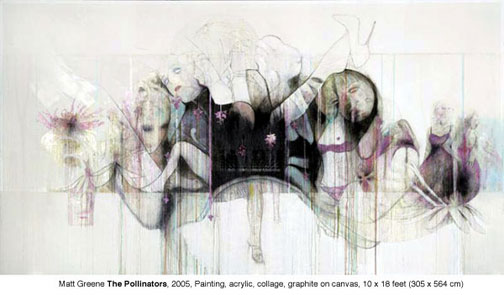 FANZINE: In the piece you created for author Trinie Dalton’s show at Yerba Buena, you included images of berserkers and werewolves. What is the significance of fantastical and imaginary beings in your work?
FANZINE: In the piece you created for author Trinie Dalton’s show at Yerba Buena, you included images of berserkers and werewolves. What is the significance of fantastical and imaginary beings in your work?
GREENE: Of course that was a werewolf-themed show, but I’m pretty interested in wild people on my own accord. It was fun to dress up in wolf skins (made out of car seat covers) to make reference photos for that work. There is a recent mythology that the berserkers ate amanita muscaria mushrooms to hallucinate themselves into an atavistic state before battling the Roman invaders that eventually replaced them. This seems a little at odds with the fact that those mushrooms cause profuse vomiting and diarrhea and poor motor skills. The figures in that painting ("the participants") are consumed by brown miasma that could be read as their own excrement after eating the mushrooms.
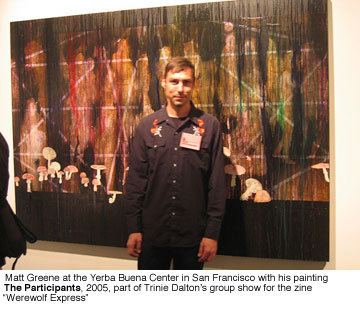 FANZINE: I was told about a recent talk by Eric Fischl on the Death of Painting. Fischl said basically it’s gotten less and less balls-y since 9-11. (Painting, having died so many times, must be a strange zombie…). This ‘death’ seems to get mixed up with taste preferences or a generally declining freshness of older styles/kicks/schools. What do you think of Painting lately? You seem to have been grouped into the ‘neo-Gothic’ aesthetic. Does that mean anything to you? Do any painting genre names post 9-11 mean much to you?
FANZINE: I was told about a recent talk by Eric Fischl on the Death of Painting. Fischl said basically it’s gotten less and less balls-y since 9-11. (Painting, having died so many times, must be a strange zombie…). This ‘death’ seems to get mixed up with taste preferences or a generally declining freshness of older styles/kicks/schools. What do you think of Painting lately? You seem to have been grouped into the ‘neo-Gothic’ aesthetic. Does that mean anything to you? Do any painting genre names post 9-11 mean much to you?
GREENE: People love to say that painting has died and I honestly don’t know what that means. We had been making images for 5000 years, but we just quit? Our eyes started rotting and falling out of their sockets? Italy ran out of soil to make pigment with? This is a sentimental narrative that propels the marketplace. Every four years someone wants to proclaim the death of painting and two years later we can all be amazed that painting is "back". I far prefer a dialectic model of art history to the phoenix.
Violence is not new. We live on an overpopulated planet in a chaotic universe. We have always been in endless conflict with each other and this seems unlikely to change. If we look further back in history we can watch empires expand, become unstable and collapse over and over again. there are countless outlets for the discussion of tragedy in current events… the thing that interests me about painting is precisely that it is an old, clumsy physical form on which to project our fantasies. I like the challenge of adapting this medium to my "time". As I’ve said before, I don’t really believe that people have changed that much in the last few thousand years.
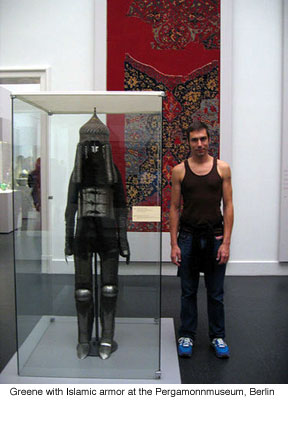 FANZINE: My grandmother likes to proclaim the end of the world, which, according to her is in 50 years. I get pissed off, naturally, because she’ll most likely be dead by that time so she can laugh about it. This is totally related to my question: Do you have any dream projects, or ones currently unrealized, that you would like to make?
FANZINE: My grandmother likes to proclaim the end of the world, which, according to her is in 50 years. I get pissed off, naturally, because she’ll most likely be dead by that time so she can laugh about it. This is totally related to my question: Do you have any dream projects, or ones currently unrealized, that you would like to make?
GREENE: I’ve always wanted to build a log cabin in the woods. I will often think while working on a painting: this activity is a substitute for cabin-building and living off the land. instead of building a cabin I am building a castle in the air. maybe the fantasy of self-sufficiency is rooted in the same beat-the-system fantasy of dying before the end of the world.
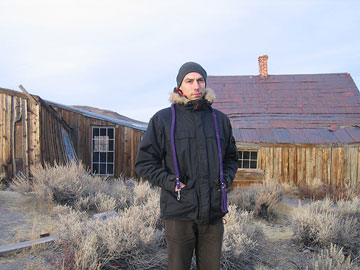 FANZINE: What is your actual process of creation in the studio? You said before it is intuitive (ejaculation model), but you also said you’re trying to make it more like playing chess. Further, do you listen to music? Do you take breaks? Are you 9 to 5 like Richter? Does painting make you calm or stress you out?
FANZINE: What is your actual process of creation in the studio? You said before it is intuitive (ejaculation model), but you also said you’re trying to make it more like playing chess. Further, do you listen to music? Do you take breaks? Are you 9 to 5 like Richter? Does painting make you calm or stress you out?
GREENE: Painting doesn’t really make me calm at all. My work is born of frustration and this frustration will hopefully reach some ecstatic resolution and then the painting will be done. The tension is between my mental picture of what the piece should be and the attempt to realize it without becoming a dictator – I try to remain receptive to associative thinking all along the way. I can be calm afterwards but making art is always a challenge of some kind. I accept that the work is going to be a flawed fragment of the concept – I just want to make certain it’s the correct fragment.
I like to get up with the sun and read or run errands and work about six intense hours and then go for a hike in the mountains. That’s what keeps me calm. This is something I learned in Berlin – that six focused hours in the studio and four hours of walking are more productive than ten hours of work.
Music really helps keep me tune out the rest of the world and focus on my work. Right now I’m listening to slow meditative stuff like Alice Coltrane and new drone bands like Sunn O))) and Growing; I love Delia Gonzales and Gavin Russon’s "Days of Mars", John Fahey, electric Miles. Music and sports have a real concrete relationship to time: they keep the participants locked in a constantly unfolding present. There is no room for neurotic second guessing in these forms. I try to carry that sense of total attention to the present into the studio – improvising, responding to terrain, maintaining rhythms, changing modes. This is culture’s capacity to maintain the senses.
All photos of Green’s work courtesy of Peres Projects Los Angeles/Berlin. More are available online
